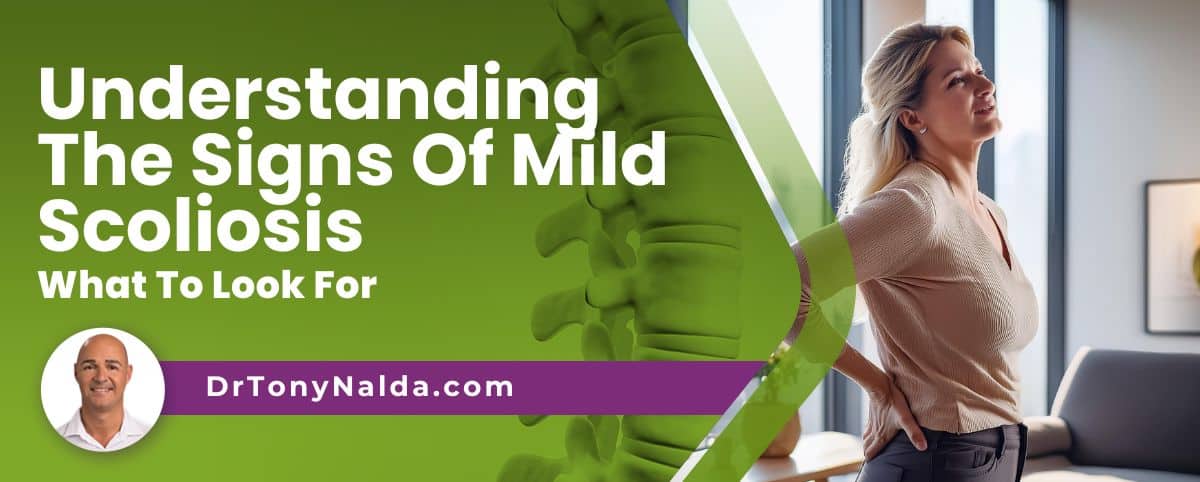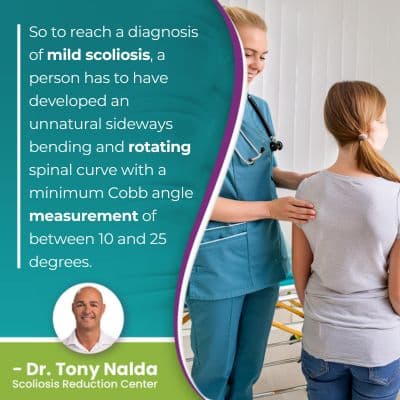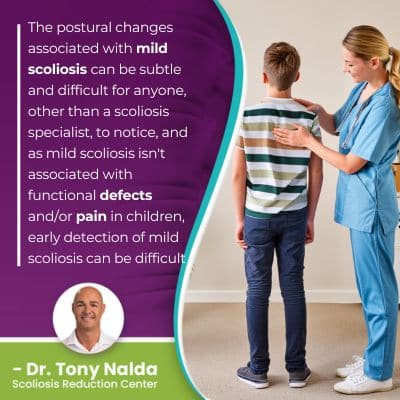Understanding The Signs Of Mild Scoliosis: What to Look for

Understanding the signs of mild scoliosis can lead to early detection, and while there are never treatment guarantees, when early detection is achieved and responded to with proactive treatment, there are fewer limits to what nonsurgical treatment can achieve.
There are different severity levels of scoliosis from mild scoliosis to moderate scoliosis, severe and very severe scoliosis. Condition severity is determined by a measurement known as Cobb angle, and the signs of mild scoliosis can be subtle and often involve uneven shoulders and hips.
No two cases of scoliosis are the same which is why diagnosing the condition involves further classifying it based on key patient/condition variables.
Table of Contents
Diagnosing Mild Scoliosis
A healthy spine is naturally curved at each of its main sections: the cervical spine (neck), the thoracic spine (middle/upper back), and the lumbar spine (lower back), and these curves make the spine stronger, more flexible, and better able to absorb and distribute mechanical stress evenly during activity.
Diagnosing mild scoliosis means an unnatural spinal curve that bends to the side and rotates has developed, and the minimum size of a scoliotic curve is 10 degrees, and this is determined by a patient's Cobb angle measurement.
A patient's Cobb angle measurement is determined during X-ray and involves drawing lines from the tops and bottoms of the curve's most-tilted vertebrae at its apex, and the resulting angle is expressed in degrees.
The higher a Cobb angle, the further out of alignment the spine is, the more noticeable a condition's symptoms are likely to be, and the easier a condition is to recognize and diagnose.
 So to reach a diagnosis of mild scoliosis, a person has to have developed an unnatural sideways bending and rotating spinal curve with a minimum Cobb angle measurement of between 10 and 25 degrees.
So to reach a diagnosis of mild scoliosis, a person has to have developed an unnatural sideways bending and rotating spinal curve with a minimum Cobb angle measurement of between 10 and 25 degrees.
- Mild scoliosis: Cobb angle measurement of between 10 and 25 degrees
- Moderate scoliosis: Cobb angle measurement of between 25 and 40 degrees
- Severe scoliosis: Cobb angle measurement of 40+ degrees
- Very-severe scoliosis: Cobb angle measurement of 80+ degrees
What's important to understand is that as a progressive condition, even patients who are diagnosed with mild scoliosis can progress to become moderate, severe, or very severe, especially if left untreated or not treated proactively.
Symptoms of Mild Scoliosis
The symptoms of mild scoliosis differ between children and adults.
While scoliosis affects all ages, it's most commonly diagnosed in children, but also affects adults, and the most common age group affected by scoliosis are adolescents, and this is diagnosed as mild adolescent idiopathic scoliosis between the ages of 10 and 18.
In childhood scoliosis, the main signs of scoliosis are postural changes, and this is due to the condition's uneven forces disrupting the body's overall symmetry.
As a progressive condition, the nature of scoliosis is to get worse over time, and this means the size of the unnatural spinal curve is increasing, as are the condition's uneven forces, and their effects.
In children, the earliest signs of scoliosis are often uneven shoulders and hips, and additional signs of mild scoliosis can include the development of a rib cage arch, and an uneven waistline.
If mild scoliosis is left untreated and progresses to becoming moderate scoliosis, the postural changes are more overt, and this is why most of my patients are diagnosed with moderate scoliosis because it's often not until conditions have progressed from mild to moderate that their signs become noticeable.
The postural changes associated with mild scoliosis can be subtle and difficult for anyone, other than a scoliosis specialist, to notice, and as mild scoliosis isn't associated with functional defects and/or pain in children, early detection of mild scoliosis can be difficult.
Mild Scoliosis and Pain
No one wants to experience pain, but it does serve a vital function; it tells us when something is wrong with the body.
Scoliosis doesn't become a compressive condition until skeletal maturity has been reached; for children whose spines are still growing, the constant lengthening motion of growth counteracts the compressive force of the unnatural spinal curve.
For adults, the main symptom of scoliosis is pain, and this can involve back pain and/or pain that radiates into the extremities due to nerve compression.
So for children with mild scoliosis, the lack of pain is a challenge to early detection and can make the early stages of scoliosis difficult to recognize.
Mild scoliosis pain in adults is likely to be felt in the area of the spine affected by the scoliosis and in its surrounding nerves and muscles.
So if the signs of mild scoliosis are understood and recognized, what's the benefit to scoliosis treatment?
Early Detection of Mild Scoliosis
I keep mentioning early detection, and this is because when scoliosis is diagnosed while a condition is mild, this is when it's most likely to be responsive to treatment.
Mild scoliosis curves are smaller, more flexible, and as significant progression hasn't yet occurred, the condition's effects are not yet well established; it's far more effective to proactively work towards preventing progression and increasing symptoms than it is to attempt to reverse them once established.
Early detection is beneficial because as scoliosis progresses, the spine becomes increasingly rigid, making it less responsive to treatment and making it difficult for some patients to perform key therapeutic exercises as part of treatment.
As scoliosis progresses, in addition to postural changes and pain, disruptions to coordination, balance, and gait are also common, and these changes will also get more noticeable, along with a prominent lean to one side that's most noticeable when in a forward bend position.
When mild scoliosis is diagnosed, the most important decision to be made is how to treat it because this will shape the spine's long-term spinal health and function.
The two main treatment responses are surgical and nonsurgical, and scoliosis surgery is a costly, lengthy, and invasive procedure that can cost the spine in a number of ways.
Conservative Nonsurgical Scoliosis Treatment
 The biggest benefit to the early detection of mild scoliosis is that when addressed proactively, progression and the need for invasive surgical treatment in the future can be avoided.
The biggest benefit to the early detection of mild scoliosis is that when addressed proactively, progression and the need for invasive surgical treatment in the future can be avoided.
Here at the Scoliosis Reduction Center, my patients benefit from a modern conservative treatment approach that integrates multiple conservative treatment disciplines so conditions can be impacted on every level.
Conservative treatment is also commonly referred to as functional and/or chiropractic-centered treatment because its approach prioritizes preserving as much of the spine's natural strength and function as possible.
Chiropractic care is applied in the form of manual adjustments and a variety of techniques that can work towards repositioning the most-tilted vertebrae of the curve back into alignment with the rest of the spine.
Impacting scoliosis structurally is the most important in the form of a curvature reduction, but another key facet of treatment is physical therapy and scoliosis-specific exercises that can strengthen the spine's surrounding muscles and abdominal muscles so the spine is optimally supported and stabilized.
For childhood scoliosis, corrective bracing can help by pushing the spine into a corrective position, complementing the corrective results being worked towards through the other types of treatment.
The final and ongoing phase of treatment is rehabilitation, and this involves continued chiropractic care and the prescription of home exercises patients can easily perform on their own to continue to heal and stabilize the spine.
Remember, as a progressive condition, there is no curing scoliosis; treatment is more about how best to manage a life-long condition for the best quality of life, and with early detection and the power of conservative treatment, scoliosis can be highly treatable.
Conclusion
Understanding the signs of a mildly curved spine can mean reaching a diagnosis early and having the option to respond proactively or not.
The benefits of a proactive conservative treatment response is that when successful, it can help prevent progression, increasing condition effects, and the need for invasive surgical treatment in the future.
Spinal fusion surgery can cost the spine in terms of its overall health, strength, flexibility, and function, and a fused spine will always be weaker and more vulnerable to injury.
Conservative treatment offers a nonsurgical alternative that works towards reducing the size of the scoliotic curve on a structural level, applies physical therapy and scoliosis-specific exercises to increase core strength, uses corrective bracing to augment corrective treatment results, and rehabilitation for long-term sustainable treatment results.
The symptoms of scoliosis, particularly when mild, can be subtle and difficult for anyone other than a scoliosis specialist trained to recognize, and as scoliosis is the leading spinal deformity among school-aged children, awareness is warranted.
Knowing how to recognize the signs of mild scoliosis doesn't guarantee treatment success, but it is associated with better results.
Dr. Tony Nalda
DOCTOR OF CHIROPRACTIC
After receiving an undergraduate degree in psychology and his Doctorate of Chiropractic from Life University, Dr. Nalda settled in Celebration, Florida and proceeded to build one of Central Florida’s most successful chiropractic clinics.
His experience with patients suffering from scoliosis, and the confusion and frustration they faced, led him to seek a specialty in scoliosis care. In 2006 he completed his Intensive Care Certification from CLEAR Institute, a leading scoliosis educational and certification center.
About Dr. Tony Nalda
 Ready to explore scoliosis treatment? Contact Us Now
Ready to explore scoliosis treatment? Contact Us Now





